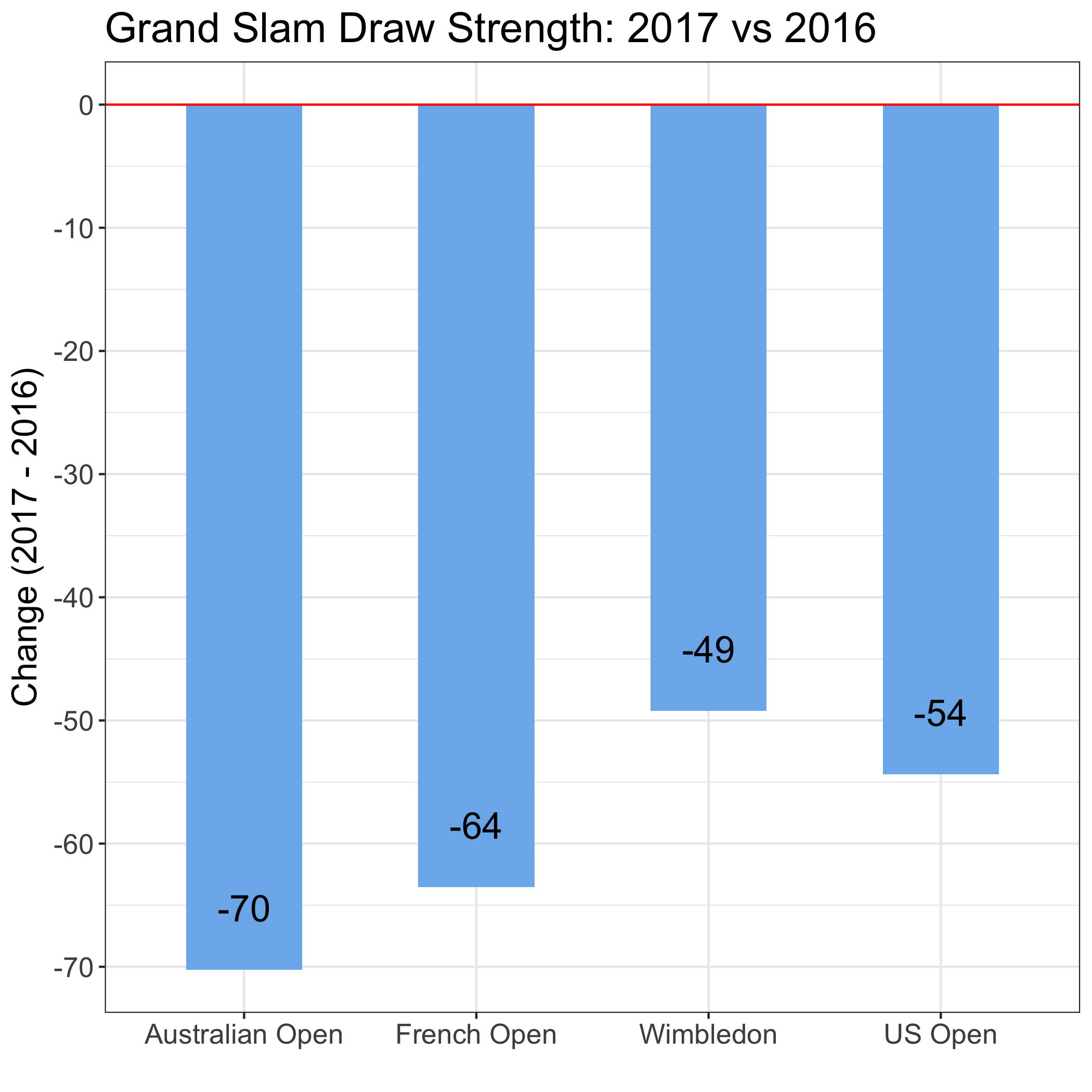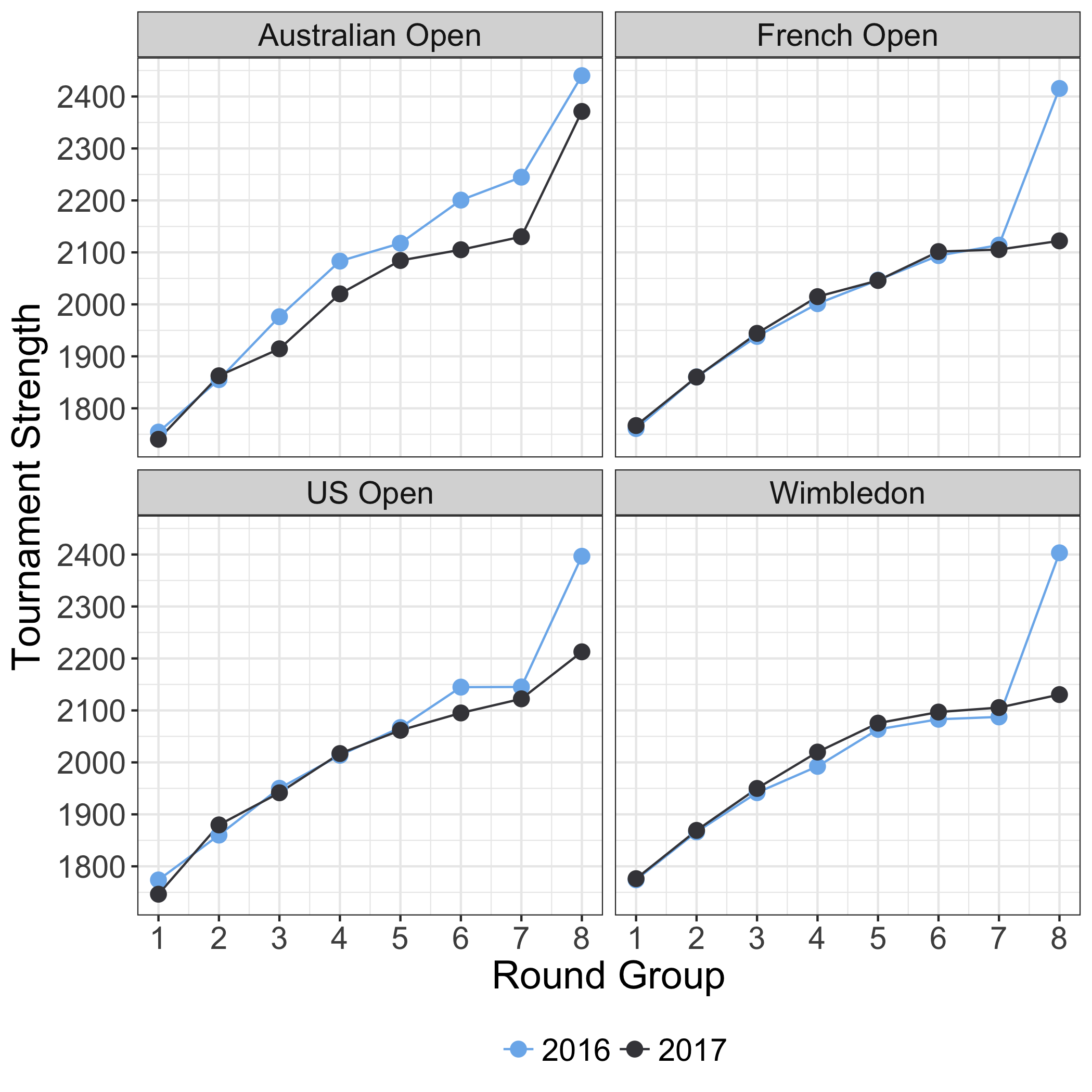Women's Slam Strength Also Down in 2017
In 2016, Angelique Kerber and Garbine Muguruza shocked tennis with Major wins. This year, Jelena Ostapenko and Sloane Stephens were the unexpected first-time slam title-holders. Who, if any of these winners, were helped by an easier Grand Slam field?
In my last post, I took a look at the tournament strength of the men’s Grand Slams in 2017 and showed that all the slams but the Australian Open dropped in strength compared to 2016. The quality of the field at the US Open suffered the most in 2017.
Was the trend similar on the women’s side?
Slam Draw Strength
Using the ‘tournament strength’ stat I introduced some weeks back, we can summarize the change in the quality of the women’s fields at slams in 2017 compared to 2016. The chart below gives the overall strength comparison. Negative values indicate a decline in draw strength in 2016 compared to 2017.

We can see that all of the 2017 women’s slams were down from last year. However, unlike the men’s game that got progressively more depleted deeper in the calendar, the women’s tour got off to a rocky start but tended to improve later in the season. At -70 points, the Australian Open had the biggest drop in draw strength from 2016. The French Open wasn’t much better with -64 points.
Wimbledon and the US Open both had smaller deficits though the gains in strength weren’t massive. Both events were still more than 45 points down in strength compared to the 2016 draws.
Why does the pattern look so different compared to the men’s?
The pattern in slam strength for the men’s tour was driven primarily by the slumps of Novak Djokovic and Andy Murray and the exodus of a number of injury-laden top players by the time of the US Open. The women’s game also had some major absences from the tour in 2017 but most of them came at the beginning of the season. Just consider some of the names that, for various reasons, weren’t in the main draw at the 2017 Australian Open: Maria Sharapova, Victoria Azarenka, Petra Kvitova, Ana Ivanovic, Sloane Stephens, Madison Keys.
Then, by the French Open, while some of these names were making a comeback, Serena Williams had announced her pregnancy and her exit from the rest of the 2017 season.
Slam Draw Strength by Round
We can look at the round-by-round breakdown in strength to see how the absences at the start of the season and the post-AO departure of Serena Williams both affected the quality of draws over the calendar.

The chart below shows the most unusual divergence at the Australian Open, where 2017 had a decline in draw quality from the third round on—a clear sign that the top of the tour was diminished at that time. For the rest of the year, it was the expected champion’s position where most of the strength was lost.
In 2016, Serena Williams held the highest Elo rating going into each of the Grand Slams. Her highest pre-slam Elo that season was 2440 and her lowest was 2397. In 2017, Williams was the expected and eventual champion at the Australian Open, even with a slightly lower Elo rating going into the event compared to her 2016 level (2371).
Once Serena Williams went on her hiatus, the highest Elo rating of a women’s player at a slam was 2213. Thus, just as even the top male players at slams in 2017 were shadows of Novak Djokovic’s level in 2016, the women’s players after the 2017 Australian Open were far from Serena Williams' level in 2016.
Still, the absence of a super-dominant player can create depth at a slam. And many viewers had the impression that, after the first quarter of the calendar, women’s matches were generally more exciting at the Majors overall than the men’s.
The absence of a near-certain winner from the French Open on also allowed for two first-time Champions— Jelena Ostapenko and Sloane Stephens—to be crowned. If the narratives of these and other young players on the WTA tour continue to develop next year, we could look back at 2017 as a springboard year.
The code and data for this post can be found here.

